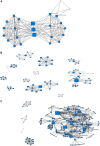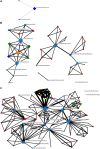Nanomedicine drug delivery in South Africa: a retrospective study on research, funding and collaboration
- PMID: 38235118
- PMCID: PMC10792447
- DOI: 10.3389/fphar.2023.1317137
Nanomedicine drug delivery in South Africa: a retrospective study on research, funding and collaboration
Abstract
After nearly two decades of substantial investment in the field of nanomedicine within South Africa, this study undertakes an investigation into the specific diseases that have been targeted for research and development, as well as the key actors and collaborative networks involved in this burgeoning field. To accomplish this, the study adopts a mixed-method approach, combining bibliometric and scientometric techniques alongside a comprehensive review of existing literature. The study's findings illuminate that the diseases selected for emphasis in nanomedicine research closely align with the prevalent health challenges faced by South Africa. Notably, these ailments encompass cancer, bacterial infections, and tuberculosis, all of which significantly contribute to the country's disease burden. Furthermore, the investigation highlights that research-intensive South African universities play a pivotal role as the primary actors in advancing nanomedicine initiatives. Over time, collaborative endeavors among these key actors have seen a noteworthy upswing. These collaborations have fostered robust connections between South African institutions and counterparts in Asian nations and the Middle East. It is worth emphasizing that nanomedicine is a resource-intensive field, necessitating substantial capital investment. Collaborative initiatives have, in turn, granted access to critical infrastructure and materials that would have otherwise been beyond the reach of some participating entities. Remarkably, these collaborative partnerships have not only facilitated scientific progress but have also cultivated social capital and trust among involved stakeholders. These valuable intangible assets hold great potential as South Africa advances towards more exploitative phases of technology development within the domain of nanomedicine. Moreover, South Africa is strategically positioning itself to cultivate a critical mass of expertise in nanomedicine, recognising the significance of skilled human resources in harnessing the full potential of this technology in the future. Systematic Review Registration: https://www.ncbi.nlm.nih.gov/pmc/articles/PMC6173875/.
Keywords: actor-collaboration networks; disease; drug delivery; funding; nanomedicine; nanotechnology; networks.
Copyright © 2024 Salie and Saidi.
Conflict of interest statement
The authors declare that the research was conducted in the absence of any commercial or financial relationships that could be construed as a potential conflict of interest.
Figures







References
-
- Baranyai Z., Soria‐Carrera H., Alleva M., Millán‐Placer A. C., Lucía A., Martín‐Rapún R., et al. (2021). Nanotechnology‐based targeted drug delivery: an emerging tool to overcome tuberculosis. Adv. Ther. 4 (1), 2000113. 10.1002/adtp.202000113 - DOI
-
- Borgatti S. P. (2002). NetDraw: graph visualization software. Harvard: Analytic Technologies.
-
- Borgatti S. P., Everett M. G., Freeman L. C. (2002). Ucinet for Windows: software for social network analysis, 6. Harvard, MA: Analytic Technologies, 12–15.
Publication types
LinkOut - more resources
Full Text Sources

